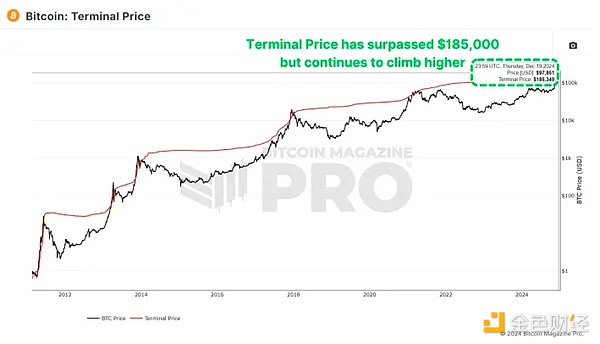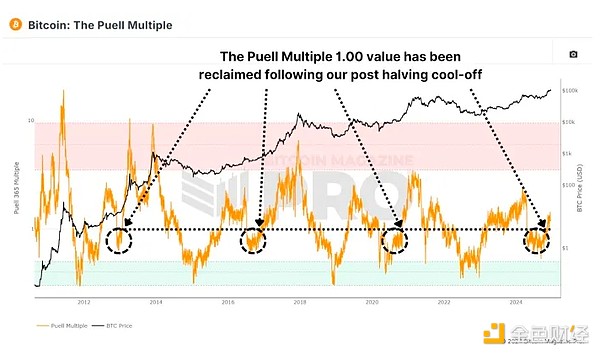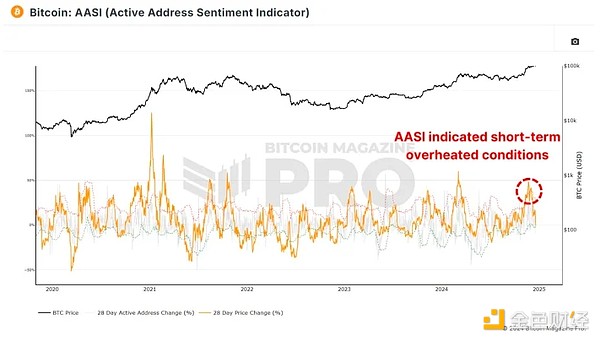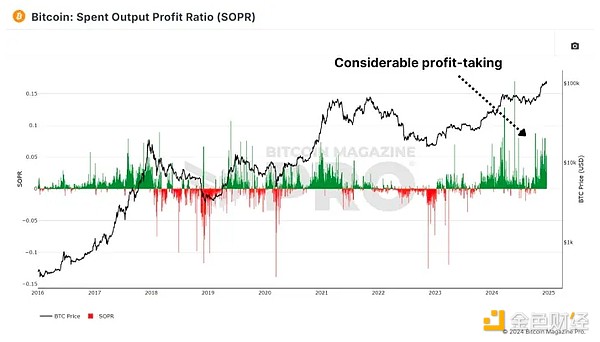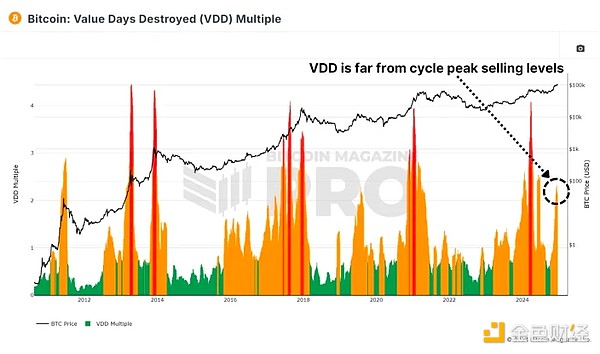Author: Matt Crosby, Bitcoin Magazine; Compiled by Tong Deng, Jinse Finance
As Bitcoin prices have become a norm in the six-figure range, and even higher prices seem inevitable, analysis of key on-chain data provides valuable insights into the potential health of the market. By understanding these metrics, investors can better predict price trends and prepare for potential market peaks, or even any upcoming corrections.
Terminal Price
The Terminal Price metric, which combines Coin Days Destroyed (CDD) and considers Bitcoin's supply, has historically been a reliable indicator for predicting the peak of Bitcoin cycles. Coin Days Destroyed measures the speed of token transfers, taking into account both holding time and the amount of Bitcoin moved.
Figure 1: Bitcoin's Terminal Price has exceeded $185,000.
Currently, the Terminal Price has exceeded $185,000 and may rise to $200,000 as the cycle progresses. Given that Bitcoin has already surpassed $100,000, this suggests we may still see several more months of positive price action.
Puell Multiple
The Puell Multiple evaluates miners' daily revenue (in USD) relative to its 365-day moving average. After the halving event, miner revenue dropped sharply, forming a period of consolidation.
Figure 2: The Puell Multiple has risen above 1.00.
Now, the Puell Multiple has risen above 1, indicating that miners will return to profitability. Historically, crossing this threshold suggests the bull market cycle has entered its late stage, typically marked by exponential price increases. Similar patterns have been observed in all previous bull markets.
MVRV Z-Score
The MVRV Z-Score measures the market value relative to the realized value (the average cost basis of Bitcoin holders). It is standardized as a Z-score to account for the asset's volatility, and it has been highly accurate in identifying cycle peaks and troughs.
Figure 3: The MVRV-Z score remains well below previous peaks.
Currently, Bitcoin's MVRV Z-score is still below the overbought red zone, at around 3.00, indicating there is still room for growth. While peak declines have been a trend in recent cycles, the Z-score suggests the market is far from reaching an exuberant top.
Active Address Sentiment Index
This metric tracks the 28-day percentage change in active network addresses and the corresponding price change. When price growth outpaces network activity, it suggests the market may be temporarily overbought, as the positive price action may not be sustainable given network utilization.
Figure 4: The AASI indicates that above $100,000 is overbought.
Recent data shows that after Bitcoin rapidly climbed from $50,000 to $100,000, the market has cooled slightly, suggesting a healthy consolidation period. This pause may lay the foundation for long-term sustained growth and does not necessarily mean we should be pessimistic about the medium to long-term outlook.
Spent Output Profit Ratio
The Spent Output Profit Ratio (SOPR) measures the realized profits from Bitcoin transactions. Recent data shows an increase in profit-taking, which may indicate we are entering the late stages of the cycle.
Figure 5: SOPR shows large profit-taking clusters.
One factor to consider is the increasing use of Bitcoin ETFs and derivatives. Investors may be shifting from self-custody to ETFs for ease of use and tax benefits, which could impact SOPR values.
Value Days Destroyed
The Value Days Destroyed (VDD) multiple expands on CDD by weighting larger long-term holders. When this metric enters the overbought red zone, it typically signals a significant price peak, as the largest and most experienced market participants start to take profits.
Figure 6: VDD is a bit hot, but not too hot.
While Bitcoin's current VDD levels suggest the market is slightly overbought, historical data shows that Bitcoin can maintain this range for months before reaching a peak. For example, in 2017, VDD indicated overbought conditions nearly a year before the cycle reached its top.
Conclusion
Collectively, these metrics suggest that Bitcoin is entering the late stages of the bull market. While some indicators point to a near-term cooling or slight overextension, most metrics indicate there is still substantial upside potential throughout 2025. Key resistance for this cycle may emerge between $150,000 and $200,000, and as we approach the peak, metrics like SOPR and VDD will provide clearer signals.


